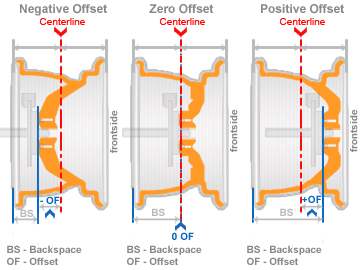The offset of a wheel is what locates the tyre and wheel/rim assembly in relation to the suspension.
More specifically, it's the measured distance between the mounting pad (the mounting surface of the wheel) and the center line of the rim. Sometimes It's used interchangeably with the term "backspace".

Nearly every wheel has the offset stamped on it somewhere, usually ingraved on the wheel as a part of the wheel markings (e.g., 6½ J x 15 H2 5/112 ET39 - ET39 means 39mm offset) and its measurement unit is millimeter (mm). The wheel offset can have zero, positive or negative value.
The wheel has "positive offset" when the mounting pad is outboard of the centerline, towards the street, located closer to the face of the wheel in relation to the centerline.
The wheel has "negative offset" when the mounting pad is on the inboard side of centerline, towards the suspension, located closer to the back side of the wheel in relation to the centerline.
The wheel has "zero offset" when the mounting pad position is in line with the position of the centerline.
e.g., If the wheel is declared as 6 inches (1 inch = 25.4mm) wide with a ½ inch lip width, it is: 152.4mm + 2 x 12.7mm = 177.8mm wide overall. With the declared positive offset of 40, the wheel's mounting pad is located 40mm from the center line, towards wheel's front face, being 40mm from the center line position which is at 88.9mm.
This means that the mounting pad location measures 48.9mm (88.9 - 40) from the front side plane of the wheel (the wheel frontspace) and 128.9mm (88.9 + 40) from the back side plane of the wheel (the wheel backspace). These measurements refer to the shortest distance between measurement points.
A wheel that has a positive offset or greater backspace has to slide further into the wheel well to be mounted, it's closer to the brakes and the suspension of a car. Similarly, the one with a negative offset or lesser backspace will tend to jut closer, or even beyond the fenders.
Terminology
Declared/rated wheel width
The width of a wheel is the distance from the inboard bead seat to the outboard bead seat (the bead seat is the place where a tyre sits inside the wheel). The rated width of the wheel doesn't include the lip (the flange) on each side of the wheel.
Overall wheel width
The overall width of a wheel includes the lip width (or the flange width - the wall thickness on the sides of the rim) on each side of the wheel. The overall wheel width is the sum of the rated wheel width and the width of lips.
e.g., If the rated wheel width is 6in and the lip width is ½in, the overall wheel width is: the rated wheel width + 2 x lip width = 6in + 2 x ½in = 7in.

Centerline of the wheel
The centerline of the wheel marks the center of the wheel's width. This is the line which vertically divides the wheel into halves, in the direction of the wheel movement.
Mounting pad (plate, hub face, hub mounting face/surface)
The mounting pad of the wheel is the mounting surface of the wheel, the flat surface on the back side of the wheel's plate which contains the holes for bolts which tighten the wheel to the car's axle pad.
Why are these measurements: offset and backspace, important?
If you intent to change the wheels on your car, replacing them with the new wheels, make sure that the new, custom wheels have offset/backspace that is as close as it can be to the offset/backspace of the original wheels - the ones that you know work well - because a very different offsets may cause problems.
If you have too little backspace (negative offset), then your tires may rub the fenders. However, too much backspace (positive offset) and a wheel is more likely to rub the brake (the brakes not fitting well within the new wheels) or the suspension components.
As you can see, the backspace and the offset are closely related. Many manufacturers have done the work for you by using both measurements in their product descriptions. If you want to calculate them on your own, our calculator: wheel offset/backspace calculator can help you.
Related articles:
- Read more about Wheel backspacing.
- Try our Wheel Offset/Backspace Calculator which calculates the offset and the backspace, the important measurements for positioning the wheel/tyre assembly inside the wheel well.
- Find out which wheel/rim sizes are appropriate for your tyres with our Wheel/Rim Size Calculator.
- Tyre size for wheel size/width calculator tells you what tyre sizes to go for, for the size of your wheel.
